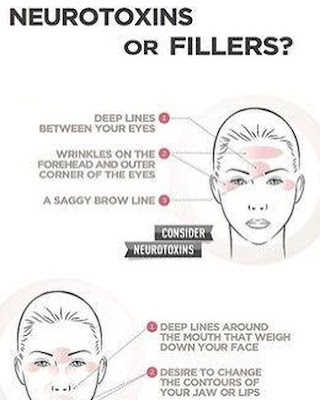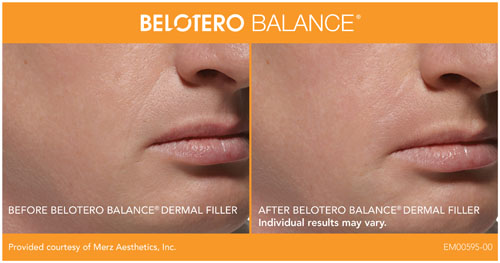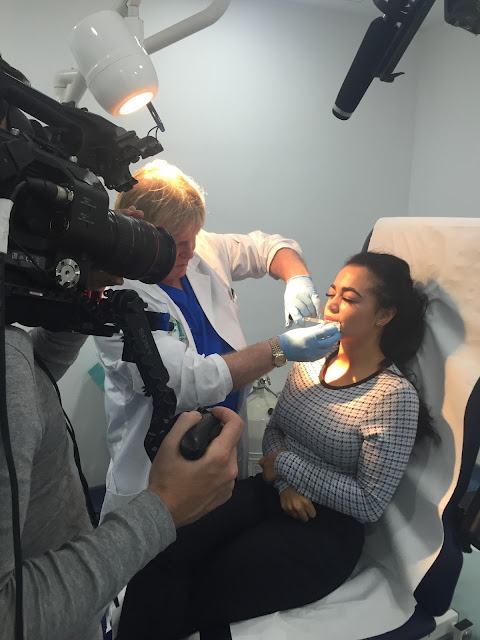Friday, December 29, 2017
Friday, December 22, 2017
Friday, December 15, 2017
How Botox Injections Work?
A wrinkle in the skin is typically formed perpendicular to a contracting muscle located directly beneath it. For example, the muscle in the forehead is a vertical muscle, and when it contracts (such as when you raise your eyebrows), the lines that form (wrinkles) will be horizontal.
Botox is not a dermal filler. Instead, it blocks nerve impulses that cause muscles to contract and cause forehead wrinkles.
Likewise, the two muscles that are responsible for the frown lines are positioned slightly horizontally between the eyebrows, so when they contract, the frown lines appear vertical.
Botox Cosmetic is injected into muscles, where it blocks nerve impulses to those tissues. The muscle activity that causes the frown lines is reduced, and a smoother look results. Without a contracting muscle beneath it, the skin has a difficult time wrinkling.
Facial lines that exist when your face is totally relaxed are not very good candidates for Botox. These lines are better handled by the dermal fillers. Botox can frequently "soften" these lines but not always get rid of them.
The injections take about 10 minutes, and you should have no downtime afterward.
Normally you would see improvement within a few days. Botox requires two to four days for it to attach to the nerve ending that would normally stimulate the muscle to contract. The maximum effect usually occurs at about 10-14 days. Therefore, whatever effect is obtained two weeks after the injections should be considered the maximum effect that is going to occur.
botox4all.com
Wednesday, December 13, 2017
Monday, December 11, 2017
Monday, November 27, 2017
Friday, November 24, 2017
Wednesday, November 22, 2017
Friday, November 17, 2017
Wednesday, November 15, 2017
Monday, November 6, 2017
Friday, November 3, 2017
Friday, October 6, 2017
Friday, September 29, 2017
Monday, September 25, 2017
Friday, September 15, 2017
Wednesday, September 13, 2017
Wednesday, September 6, 2017
Wednesday, August 23, 2017
Monday, August 21, 2017
Thursday, August 17, 2017
Wednesday, August 16, 2017
Monday, August 14, 2017
Friday, August 11, 2017
Thursday, August 3, 2017
Wednesday, August 2, 2017
Campaign for Safe Cosmetics
Kids aren’t just “little adults.” Children are especially vulnerable to the effects of chemicals, and preventing early-life exposures to harmful chemicals can help prevent health problems throughout their lives.
Despite these concerns, children’s cosmetic products — like the ones we tested — contain carcinogens and hormone disrupting chemicals. Tell Congress: Cancer-Chemicals & Heavy Metals Don’t Belong in Kid’s Face Paint or Makeup!
https://www.facebook.com/safecosmetics/
Despite these concerns, children’s cosmetic products — like the ones we tested — contain carcinogens and hormone disrupting chemicals. Tell Congress: Cancer-Chemicals & Heavy Metals Don’t Belong in Kid’s Face Paint or Makeup!
https://www.facebook.com/safecosmetics/
Tuesday, August 1, 2017
Monday, July 31, 2017
Thursday, July 27, 2017
Tuesday, July 25, 2017
Wednesday, July 19, 2017
Friday, July 14, 2017
Monday, July 3, 2017
Friday, June 30, 2017
Facial Rejuvenation May Involve More ...
Facial Rejuvenation May Involve More Than Skin Tightening
Most people worry about developing wrinkles and want to delay the effects of aging as much as possible to ensure they look their best. However, a new study published in the Journal of Experimental Social Psychology may prove there are more drawbacks to having wrinkles than just the aesthetics.
Tuesday, June 27, 2017
Thursday, June 22, 2017
Wednesday, June 14, 2017
Thursday, June 8, 2017
More isn't always better: making better health-care choices
More isn't always
better: making better health-care choices
Canadians have more than one million
unnecessary medical tests, treatments and procedures every year. But we can
improve patient outcomes and save resources
By
Wendy Levinson
Expert Adviser
EvidenceNetwork.ca
Expert Adviser
EvidenceNetwork.ca
TORONTO,
Ont./Troy Media/ - Each year, at least one million unnecessary tests, treatments
and procedures are done in Canadian health-care settings. This means that
hundreds of thousands of Canadians are exposed to potential harm by unnecessary
care.
Unnecessary care could be a prescription drug, a diagnostic test or a
medical procedure that doesn't improve a patient's health outcomes and isn't
backed by the best available evidence. It may also involve risks and harmful
side-effects.
In other
words, this medical care offers no value to patients and strains
resources.
A recent
report from the Canadian Institute for Health Information (CIHI), in partnership
with Choosing Wisely Canada, demonstrates how pervasive unnecessary care is
across the country and highlights several key examples where changes could
benefit patients and the health system.
So what
are we better off without?
Unnecessary imaging has consequences.
The report
says about 30 per cent of patients visiting Ontario and Alberta emergency
departments for minor head injuries have CT scans. CT scans deliver strong X-ray
radiation. Exposure to this radiation can increase lifetime cancer risk. Yet evidence shows there are
good alternatives to CT scans for investigating head injuries. For example,
doctors can use a set of questions, known as a clinical decision rule, to assess
the severity of a head injury and decide if further diagnostic testing is
warranted.
Unnecessary medications have side-effects.
The report
estimates that one in 10 Canadian seniors regularly uses sleeping pills, known
as benzodiazepines, and other sedative hypnotics. The long-term use of these
medications outweighs benefits, which is why they're only recommended for
short-term use. These medications increase the risk of falls causing injuries
and car accidents in seniors.
Seniors
aren't the only population where there is unnecessary and potentially harmful
medication use. The report shows a disturbing 300 per cent increase in dispensed
prescriptions for the powerful antipsychotic quetiapine for insomnia in children
and youth in Manitoba, Saskatchewan and British Columbia. This drug is not
recommended for children or youth and has a long list of harmful
side-effects.
An
important finding of the report is wide variation across regions and between
provinces. Variation means major differences in medical practice, some of which
are not evidence-based and can be harmful to patients.
Reducing
variation improves quality for all Canadian patients and can reduce waste. A
good example is pre-operative testing. In Ontario, nearly one in three patients
having eye surgery had a preoperative test, compared to one in five in
Alberta.
Medicine
has evolved and so has medical practice. It used to be standard that before
certain surgeries, like hip or knee replacements or cataract surgery,
pre-operative tests would be done to ensure a patient was fit for surgery. These
tests could include blood work, electrocardiograms and chest X-rays. As surgical
techniques and technology evolve, however, most of these pre-operative tests are
no longer needed unless there's a specific concern.
In spite
of the pervasiveness of unnecessary care, the picture isn't bleak. The report
also provides several examples of how health-care providers work hard to put in
place better practices or protocols to reduce waste, which may also harm
patients.
We know
patients are aware of this problem, too. Ipsos Reid survey data shows that one
in four Canadians say they have experienced unnecessary care in the past year.
And 67 per cent of Canadians surveyed believe patient demand is also responsible
for unnecessary care, rather than decisions made by health-care providers alone.
Nearly half (42 per cent) of Canadians surveyed said they expect a test ordered
or a prescription written when they visit a doctor's office.
But the
vast majority (92 per cent) of Canadians surveyed also said they need more
information to help make decisions and ask the right care
questions.
So what
should patients do?
Choosing Wisely Canada, a national,
clinician-led campaign, has four key questions a patient can ask their care
provider to help start a conversation about unnecessary
care:
- Do I really need this test, treatment or procedure?
- What are the downsides?
- Are there simpler, safer options?
- What happens if I do nothing?
Together
with health-care providers, Canadians can help reduce unnecessary care by asking
questions and having conversations about when more isn't always
better.
Wendy
Levinson, MD, OC, is an expert adviser with EvidenceNetwork.ca, the chair
of Choosing Wisely Canada and a professor of medicine at the University of
Toronto.
© 2017 Distributed by Troy
Media
Wednesday, May 24, 2017
Tuesday, May 23, 2017
Friday, May 12, 2017
6 Things You Didn’t Know Happen When You Get Botox -
It may be a miracle in a bottle and the ultimate wrinkle eraser, but do you really know what’s going on when a single dose of any neuromodulator (Botox, Dysport or Xeomin) gets injected?
https://www.newbeauty.com/hottopic/blogpost/9334-6-things-you-didnt-know-happen-when-you-get-botox/
https://www.newbeauty.com/hottopic/blogpost/9334-6-things-you-didnt-know-happen-when-you-get-botox/
Wednesday, May 3, 2017
Laser treatment for permanent filler complications
Employing an intralesional laser to treat inflammatory complications caused by permanent facial fillers showed a 92% overall improvement rate, according to an Italian study that appeared in the August issue of Plastic and Reconstructive Surgery.
A total of 218 consecutive patients (204 of whom were women) with a mean age of 49 years were treated with an 808 nm diode laser (LASEmaR 800; Eufoton, Treiste, Italy) between 2006 and 2013.
Patients with infiltrating distribution in the tissues, as in crisscross retrograde injection, were managed by intralesional laser treatment alone. However, patients with cystic distribution in the tissues, as in bolus injections, were treated with both laser-assisted evacuation and drainage through stab wound incisions.
Researchers chose the 810 nm wavelength because of less associated pain than other infrared diodes.
Typically, no anesthesia is required for the laser treatment, according to the study authors, which consists of percutaneously inserting a 200-micron fiberoptic laser directly into the lesions and drilling several small holes. The result is removal of the foreign substance and the inflammatory reaction.
“A period of up to 6 months is usually necessary to fully appreciate the resolution of the lump together with the healing of the surrounding inflammation often extended far beyond the original implant,” writes lead author Daniel Cassuto, M.D., and his associates from Modena and Milan, Italy.
Tuesday, May 2, 2017
Product Review: Neckline Slimmer
http://www.plasticsurgeryportal.com/articles/neckline-slimmer-review/58
by Luke Willson
For anyone struggling with "turkey neck" or a double chin, the Neckline Slimmer sounds almost too good to be true. Two minutes a day of moving your chin up and down against something with a little spring in it? Well, that sounds easy enough. Thanks to the Neckline Slimmer's inventor Paul Younane, an ex-professional rugby player turned physiotherapist, this new, "as-seen-on-TV" fad may actually be the solution to a problem many of us have to deal with. Or is it?
The Neckline Slimmer is a portable, affordable, easily operated device, small enough to fit in a purse. To use it, one end is placed on the chest, while a moveable pad rests under the chin. A spring contained within provides resistance (different springs are provided to adjust the level of intensity). By repeatedly depressing the pad, like a bicycle pump, in a nodding motion, the claim is that noticeable tightening along the jowls will be acheived in as little as two weeks.
Younane's product works on this simple principle: prolonged resistance exercise with a muscle group reduces surrounding deposits of fat. Consequently, the skin around the area will acquire a tighter appearance. While the Neckline Slimmer is designed to target the muscles on the front and side of the neck, this principle applies to all muscle groups. The key is that persistence over time is essential - like any exercise, the results only become noticeable gradually.
As we age, our skin sags, and the neckline is often the first area to go. However, diet and exercise aren't always enough to counteract the natural process of aging. It's enough to drive one to frustration. A product like the Neckline Slimmer certainly offers the opportunity for its user to regain more youthful contours over time. Keep in mind, however, this treatment system strengthens muscle and reduces fat deposits. If you are experiencing excessive amounts of loose, sagging skin on the neck and jaw, it might not be the right option for you. Real results may require an actual cosmetic procedure, such as a neck lift.
A Neck Lift is a relatively simple cosmetic surgical procedure, like a mini-facelift for your neck, whereby loose, sagging skin is lifted and repositioned, giving you more toned, youthful definition. In fact, the Neck Lift can even be combined with a Facelift for even greater results. Or, if excessive fat is what you're looking to reduce, some minor liposuction under the chin might also be an option. A local plastic surgeon can help you decide what type of approach can deliver your desired in the simplest, safest, and quickest manner possible.
If cosmetic surgery sounds too serious, perhaps a less-invasive neckline treatment would interest you. Refirme®, which uses targeted heat energy to tighten skin, smooth out wrinkles and balance skin tone, will not only help give your neck better definition, it can even out your skin tone for an all-over luminous glow. Lipodissolve, a popular new injectable for breaking down fat deposits, is also a great non-surgical solution for slimming the neckline.
Everyone's body reacts differently to cosmetic procedures, and your specific characteristics will determine how a treatment affects you. Only a face-to-face consultation with a medical professional can give you the necessary information about your specific needs. If you'd like to learn more about any of the procedures mentioned or find a local provider, feel free to click here, or call 888.517.4187. And if you're interested in the Neckline Slimmer but would rather not buy an As Seen on Tv product, a nerf ball placed under the chin could very well offer the same type of resistance exercise!
Monday, May 1, 2017
Friday, April 28, 2017
Wednesday, April 26, 2017
Friday, April 14, 2017
Tuesday, April 11, 2017
Friday, April 7, 2017
Thursday, April 6, 2017
Wednesday, April 5, 2017
Friday, March 31, 2017
Dr Patrick Treacy ~ Botoz
Intradermal botulinum toxin effective for intractable long-term neuropathic knee pain. A study presented at WCP, held in October in Buenos Aires, showed that in patients with intractable long-term neuropathic knee pain, intradermal botulinum toxin offered improved clinical outcomes
Wednesday, March 29, 2017
Tuesday, March 28, 2017
Monday, March 27, 2017
Wednesday, March 22, 2017
Tuesday, March 21, 2017
Botox Popularity Skyrocketing in the US
Anti-wrinkle
injections have been gaining popularity for well over twenty years. In fact,
over five million injections are made annually in the United States. This simple
procedure yields immediate, fantastic results with no recovery time and can even
be completed on your lunch break. The injections are typically done on facial
tissue to lessen the appearance of wrinkles. The most common location for
injections is around the eyes and on the forehead. Botox is also
used for various other medical
purposes such as excessive sweating in the face or underarms.
The
Botox is injected into the muscle, temporarily relaxing the facial muscles that
contract and expand with normal facial expressions. Physicians use nerve
blockers to relax facial muscles, rendering the muscle unable to create new
lines or deepen current wrinkles. When the muscles are relaxed, the appearance
of wrinkles and lines is drastically reduced, leaving behind smooth skin that
looks ten years younger.
Anti-wrinkle
injections are effective, clean and even fast. The procedure is incredibly
simple and can be completed in under fifteen minutes. As little as five or as
many as ten injections are made directly at the site and the patient is free to
resume their daily activities immediately following the procedure. Patients
sometimes experience some very minor discomfort during the procedure, but the
pain should subside rather quickly.
Gold
Coast specialists Cosmos Clinic state that, after the original injection,
patients will see results in as little as three days. In some cases the full
results may take up to two weeks to become fully apparent. The result is younger
looking skin that last at least three months, but can last for up to six months.
Studies show that patients that maintain their anti-wrinkle injections with up
to three annual visits will see permanent improvement to the lines in their
skin. While maintenance on specific areas isn’t a necessity, the results are
often so pleasing that patients want to maintain them permanently.
Source: http://www.bocaratontribune.com/
Friday, March 17, 2017
Wednesday, March 15, 2017
Monday, March 13, 2017
Friday, March 10, 2017
Monday, March 6, 2017
Thursday, March 2, 2017
Botulax
Anti-aging botulinum developed by Korean doctors
Market position No.1 product in domestic market within 2 yrs.
Welcomed and proved by field plastic surgeons.
SD International
Bangyidong, Songpagu Seoul, Seoul
Subscribe to:
Posts (Atom)













































